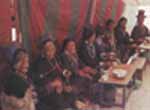
|
Early Settlement We do not know much about the early settlers in the Himalaya. People who lived in this region left rock inscriptions and ancient sites, which have given archaeologists some clues. We also have learned about the Himalaya from stories that were orally passed down or from texts written in Sanskrit. Eventually, villages developed across the mountains. The choice of where to settle depended on where people could get animals or plants. Most human settlement was in the mid-montaine region, the land from 2,500-7,500 feet in elevation. Land was the most important resource, but other natural resources included rivers, forests, and mountains. Consequently, important civilizations began in the Kashmir and Kathmandu Valleys. People could survive by planting crops, finding wood in the forests for fuel and shelter, and hunting for animals. Humans and the Land People interact with their surroundings in a variety of ways. People can depend on, adapt to, or modify, or change, their environment. Himalayan peoples are extremely diverse, but there are four groups that we can analyze as subsistence patterns. Subsistence is getting what you need in order to live. Like the early settlers, some groups are still hunter and gatherers. These people hunt, fish, and gather their needs from the wilderness. Another group still practice nomadic pastoralism. This means that they live with animal herds that support the entire community. Only a few groups of herders actually remain in the region. Mainly in the eastern part of the Himalaya, people practiced a type of agriculture called slash and burn, or jhum. This involved
1. cutting down the vegetation 2. setting the site on fire and 3. planting new crops with ash for fertilizer and bamboo poles. Today, this method is banned and only found in remote areas. Most people rely on subsistence farming. Villages are “self-sufficient economic units,” which means that people plant what they need in order to live. They do not necessarily sell their products in order to survive. Settlement/ Human-Environment Interaction Questions with Modifications and Extensions There is a delicate balance between humans and environment in the Himalayan region. The Himalayan Mountains define the boundaries of the landscape, but few people live in the mountains. Throughout the mountains are pockets of human settlement. In the highlands live the nomads, traders, and some herders. They move with the seasons. Nomadic pastoralism is when the people and their animals move from place to place to find grass and water. At the higher elevations, some groups have cattle, sheep, goats, water buffalo, yak, and even yak cattle. Some families may keep large herds to sell products, and other families may just have one cow or some goats, living in the village all year.
People get foods, such as milk and meat, from these animals, but they also provide wool and hair that are used for clothing. Salt is mined in the higher elevations and can be traded with people from the lower elevations for important resources. Even manure is important! Since there are no trees at this elevation, villagers will use the manure as fuel to heat their homes. Of course, they also use the manure for fertilizer to farm. Although there is a limit to what can be farmed, mountaineers adapt to their environments. In the highest parts of the Himalayas grow crops such as barley, buckwheat, peas, turnips, and even potatoes. Herders also use mixed farming, where various crops are planted and harvested for the increasing population density. Few groups use swidden agriculture, in which people plant certain crops based on the seasons, and leave them to go herd. Very few villagers actually limit themselves to just herding; even on the “roof of the world,” people manage to survive through a combination of herding and farming. In the mid-montaine region, most people are subsistence farmers. Terrace farming is a necessity in areas with steep slopes to avoid erosion and water runoff. People not only plant rice but may also plant maize, buckwheat, wheat, millet, mustard, vegetables, and some fruits like apples. People can change what they plant, which is called shifting cultivation, or they can trade in caravans with other communities to get what they need in order to live. Some farmers farm in the lower elevations and then go up to the high mountain grazing lands in the summer to allow their livestock to graze. In the terai, of lowlands, human-environment interaction is a combination of both herding and farming. People also may have pigs, chickens, or fish. Living close to water allows then to trade more easily, so they can sell products. Bamboo is taken from the forests for mats, thatch, and other products. Their homes are usually longhouses, some made out of mud or stone. In the past, villagers practiced slash and burn agriculture, when the vegetation is cut and then burned; eventually people move on after several years. Now the practice is illegal. The Forests and Humans Forests provide many resources that help people in the mid-montaine region to maintain their ties to the mid and highlands. The forests are like the Super Wal-mart of the Himalayan world! People use wood from the forest as lumber for building materials, but it is also used as an energy source. Over 80% of energy comes from firewood gathered in the forests. The wood is used for heating their homes and for cooking in their hearth. Leafy bits of trees, called fodder, are used to feed the livestock. Other plants, fruits, roots, and even mushrooms are used among tribal groups in eastern Nepal. Medicinal plants and herbs also are collected and traded as exports. Humans not only use the forests to meet basic needs, but they also set annual fires to burn pastures, to gather plants for medicine and to make charcoal from forest products.
Humans activities modify the environment. Deforestation is an issue. In the 1980’s, forest loss was estimated to be 2-5% per year, but now, in one year, almost 1% of the Himalayan forests are used through clear cutting the branches away from the trees. This not only changes the ecosystem, affecting the many animals and vegetation growth in the forests, but it presents natural hazards. Soil erosion and the change in the flow of the rivers in Nepal are a problem. Commercial investment and trade opportunities make forest management critical. Many agencies, research organizations, and projects such as the Nepal-Australia Forestry Project, are regenerating forests in Nepal. Another group, FECOFUN, is a group of over 18,000 user groups who work within villages to promote community forestry. This process allows community users to decide by consensus how to manage their own lands. The Himalayan region is important for understanding how humans interact with their environment. Himalayan Culture Group Lesson Plan
|
||||||||
This site was created by Amy Jane Priest at the NEH Summer Institute "Cultures and Religions of the Himalayan Region," held at the College of the Holy Cross, Summer 2006









